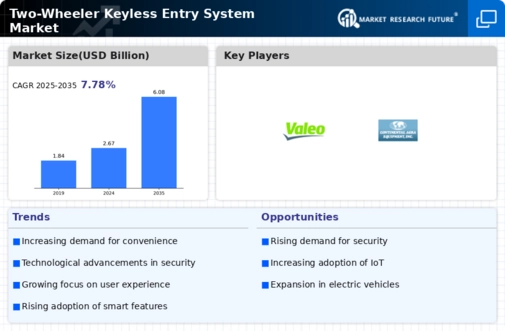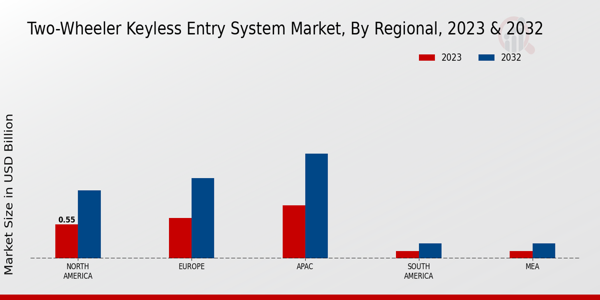Market Growth Projections
The Global Two-Wheeler Keyless Entry System Market Industry is poised for substantial growth, with projections indicating a rise from 2.67 USD Billion in 2024 to 6.08 USD Billion by 2035. This growth is underpinned by a compound annual growth rate (CAGR) of 7.77% from 2025 to 2035. The increasing adoption of keyless entry systems, driven by consumer demand for security and convenience, suggests a robust market landscape. As manufacturers innovate and enhance their offerings, the market is likely to witness a dynamic evolution, catering to the needs of a diverse consumer base.
Growing Urbanization and Motorcycle Usage
The Global Two-Wheeler Keyless Entry System Market Industry is significantly influenced by the trend of urbanization and the increasing usage of motorcycles in urban areas. As cities become more congested, motorcycles are favored for their maneuverability and fuel efficiency. This shift in transportation preference is leading to a higher demand for two-wheelers equipped with keyless entry systems. Countries like Indonesia and Vietnam are experiencing rapid urban growth, resulting in a surge in motorcycle sales. This trend is expected to bolster the market, as more consumers seek convenient and secure access to their vehicles.
Rising Demand for Enhanced Security Features
The Global Two-Wheeler Keyless Entry System Market Industry experiences a notable increase in demand for advanced security features. As theft rates of two-wheelers remain a concern, manufacturers are integrating sophisticated keyless entry systems to enhance vehicle security. For instance, countries with high motorcycle theft rates, such as Brazil and India, are witnessing a surge in the adoption of these systems. This trend is expected to contribute significantly to the market's growth, as consumers prioritize safety. The market is projected to reach 2.67 USD Billion in 2024, indicating a robust response to security needs.
Regulatory Support for Advanced Safety Features
Regulatory support for advanced safety features is shaping the Global Two-Wheeler Keyless Entry System Market Industry. Governments worldwide are recognizing the importance of enhancing vehicle security and are implementing regulations that encourage the adoption of keyless entry systems. For instance, certain regions are mandating the inclusion of advanced anti-theft technologies in new motorcycle models. This regulatory push is likely to accelerate market growth, as manufacturers align their products with these requirements. The market is projected to grow to 6.08 USD Billion by 2035, reflecting the positive impact of regulatory frameworks on consumer adoption.
Consumer Preference for Convenience and Ease of Use
Consumer preferences are evolving towards convenience and ease of use, which is propelling the Global Two-Wheeler Keyless Entry System Market Industry. Modern consumers are increasingly seeking features that simplify their daily routines, and keyless entry systems offer just that. The ability to unlock and start a motorcycle without fumbling for keys is appealing, especially in busy urban environments. This demand for user-friendly technology is likely to drive sales, as manufacturers respond by incorporating these systems into new models. The market's growth trajectory suggests that convenience will remain a key driver in the coming years.
Technological Advancements in Automotive Electronics
Technological advancements in automotive electronics are driving the Global Two-Wheeler Keyless Entry System Market Industry forward. Innovations such as Bluetooth connectivity, mobile app integration, and biometric authentication are becoming increasingly prevalent. These features not only enhance user convenience but also improve the overall riding experience. For example, manufacturers are now offering systems that allow users to unlock their vehicles using smartphones. This shift towards smart technology is likely to attract tech-savvy consumers, thereby expanding the market. The anticipated growth rate of 7.77% CAGR from 2025 to 2035 reflects the potential of these advancements.













